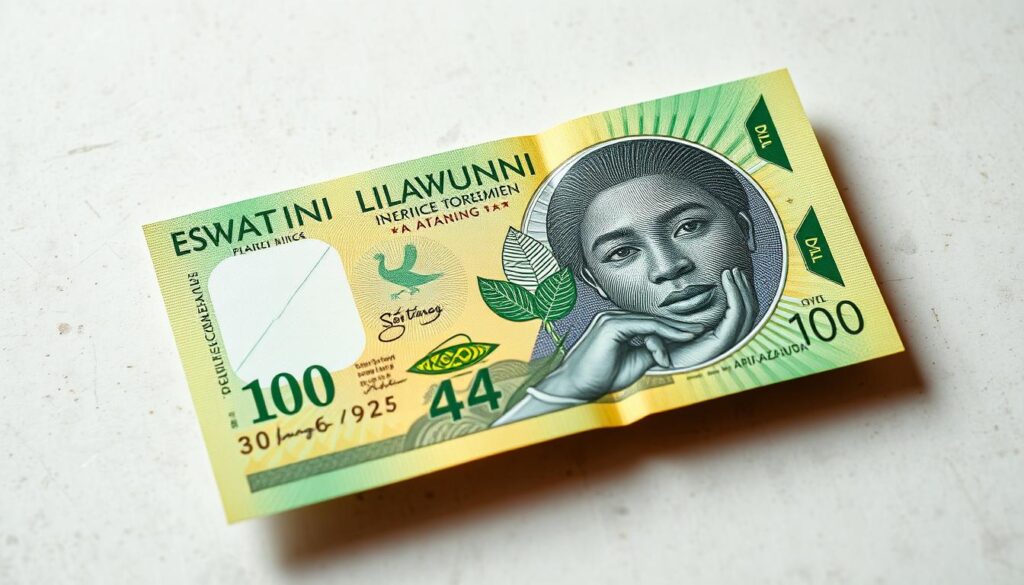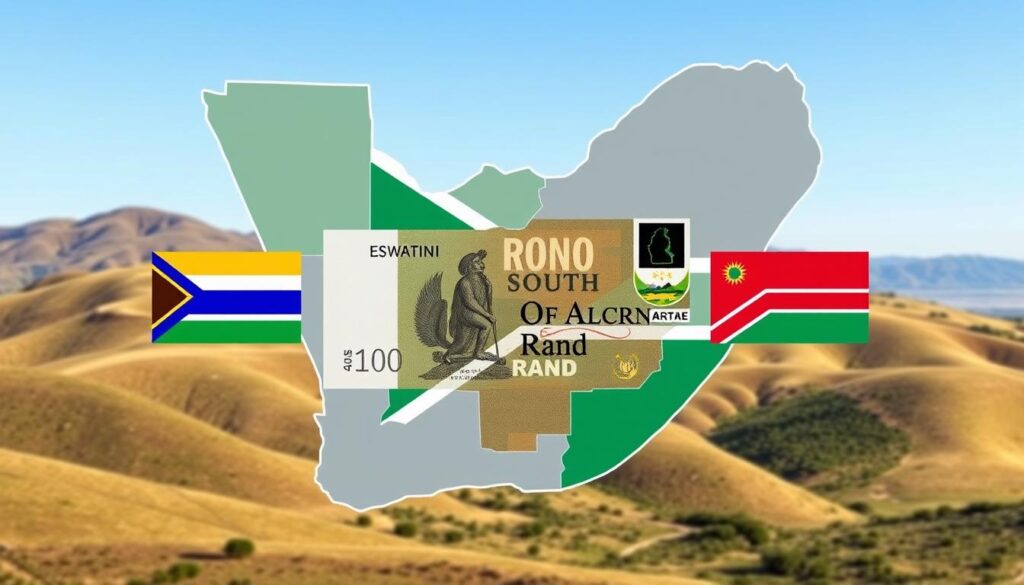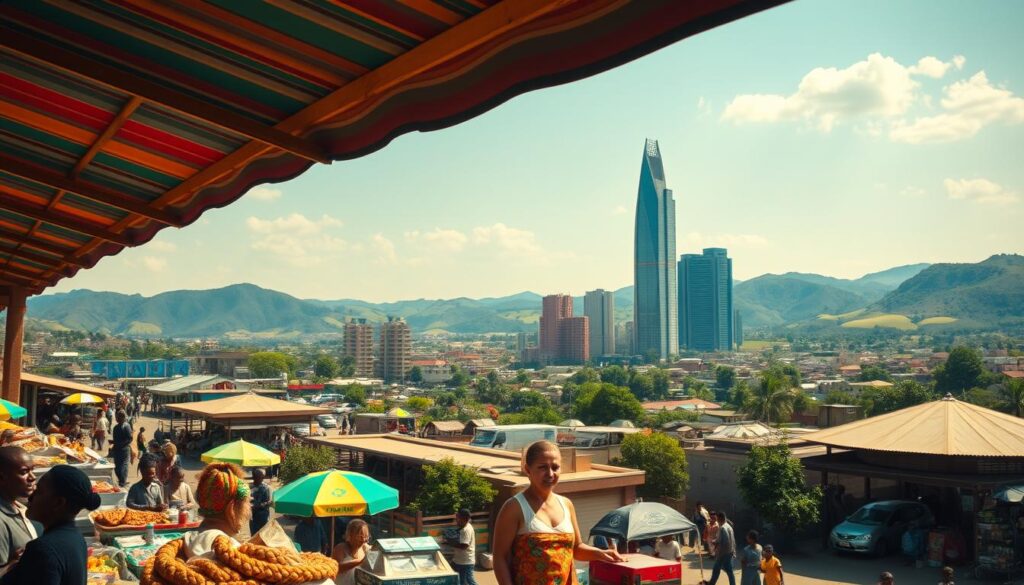
Eswatini, a country in Southern Africa, introduced its official Lilangeni (SZL) in 1974. This was a big step towards its economic freedom.
The Lilangeni, shown as “L” or “E” (plural: Emalangeni), has been the country’s legal money since then. Even though, the South African Rand (ZAR) is also widely used.
This use of two currencies shows Eswatini’s strong ties with its neighbors. It also shows its smart approach to money matters.
Key Takeaways
- The Lilangeni (SZL) is the official currency of Eswatini.
- It was introduced in 1974 to replace the South African Rand.
- The South African Rand is still widely accepted in Eswatini.
- The currency symbol for Lilangeni is “L” or “E”.
- Eswatini maintains a dual currency system for economic stability.
What Is the Currency of Eswatini: The Lilangeni Explained
The Lilangeni, or SZL, is Eswatini’s official money. It plays a key role in the country’s economy. It helps with money exchanges both at home and abroad.
Basic Information and Denominations
The Swazi Lilangeni is split into 100 cents. This makes it easy to use in many transactions. It comes in different sizes to meet various needs.
Denominations of the Lilangeni range from small coins to big banknotes. This variety makes the currency easy to use for many financial tasks.
Currency Symbol (E) and Code (SZL)
The Lilangeni’s symbol is ‘E’. It’s known as ‘SZL’ in global money exchanges. The ‘E’ symbol makes transactions simpler and clearer.
Emalangeni: The Plural Form
The word for more than one Lilangeni is Emalangeni. Knowing this is key for clear money talks. It’s especially important in formal and money-related talks.
It’s vital to know the difference between Lilangeni and Emalangeni. This helps in clear money talks about Eswatini.
Historical Background of Eswatini’s National Currency
To understand the Lilangeni, we must look back at Eswatini’s history. It was once a British protectorate and later gained independence. This journey shaped its economy and money policies.
From British Protectorate to Independence
Under British protection, Eswatini’s economy was tied to South Africa and the UK. It used the British pound and later the South African rand. Gaining independence in 1968 was a big step towards its own money system.
Eswatini gained independence in 1968. This was a key moment for introducing its own currency. Even with political freedom, its economy was still linked to others.
Evolution of the Lilangeni as Eswatini’s Monetary Unit
The Lilangeni was introduced in 1974. It was a big step in Eswatini’s economic history. The goal was to have its own money policy and less dependence on foreign currencies.
The Lilangeni is tied to the South African rand through the Common Monetary Area (CMA). This keeps the exchange rate stable and ties Eswatini to its neighbors.
Key Historical Milestones
| Year | Event |
|---|---|
| 1903 | Eswatini becomes a British protectorate. |
| 1968 | Eswatini gains independence from Britain. |
| 1974 | The Lilangeni is introduced as Eswatini’s national currency. |
The history of Eswatini’s currency shows its path to economic freedom. The introduction of the Lilangeni in 1974 was a key moment. It gave Eswatini more control over its money.
The Central Bank of Eswatini and Currency Management
The Central Bank of Eswatini plays a key role in managing the Lilangeni. It issues currency, regulates it, and keeps the economy stable.
Role and Responsibilities
The Central Bank of Eswatini is in charge of the Lilangeni. It makes sure the currency is available in the right amounts. It also keeps the financial system strong.
Key Responsibilities:
- Issuing currency
- Regulating currency circulation
- Maintaining monetary stability
- Overseeing the financial system
Currency Issuance and Regulation Policies
The Central Bank has policies to keep the Lilangeni stable. It fights inflation, keeps foreign exchange reserves, and watches over banks.
Currency issuance is a critical function that needs careful planning. It ensures the currency’s value is not lost.
| Policy Area | Description | Objective |
|---|---|---|
| Currency Issuance | Managing the supply of Lilangeni | Meet economic demands |
| Regulation | Overseeing commercial banks and currency circulation | Maintain financial stability |
| Monetary Stability | Managing inflation and foreign exchange | Preserve currency value |
The Central Bank’s annual report says, “Keeping the Lilangeni stable is key for Eswatini’s growth.” This shows how important good currency management is.
“The stability of the national currency is a cornerstone of a country’s economic health.
The Central Bank’s work on the Lilangeni is crucial for Eswatini’s economy. By controlling currency and keeping the economy stable, it helps the country’s financial health.
Lilangeni Banknotes and Coins in Detail
The Lilangeni is Eswatini’s currency, with banknotes and coins that are key to its economy. It comes in different values to meet various needs.
Current Banknote Series and Security Features
The current Lilangeni banknotes have values from E10 to E200. They have special security features to stop fake money. These include:
- Watermarks
- Holographic strips
- Microprinting
- Unique serial numbers
Advanced security features are vital to keep the currency safe. The Central Bank of Eswatini keeps updating these to outsmart counterfeiters.
Coins in Circulation
The Lilangeni is also in coin form, from 1 cent to 5 Emalangeni. These coins are for small purchases and are a big part of Eswatini’s money system. They show the country’s culture and history through their designs.
Using Lilangeni coins and banknotes together makes Eswatini’s financial system strong and adaptable.
Exchange Rates and Currency Value
The Lilangeni, Eswatini’s currency, is valued against major global currencies. Its exchange rate is tied to the South African Rand (ZAR) at a 1:1 ratio. This greatly affects its value in the foreign exchange market.
Current Exchange Rates Against Major Currencies
The Lilangeni’s exchange rates against the US Dollar (USD), Euro (EUR), and British Pound (GBP) change. These changes are based on the ZAR’s performance. Here are the latest exchange rates:
| Currency Pair | Exchange Rate |
|---|---|
| SZL/USD | 0.065 |
| SZL/EUR | 0.058 |
| SZL/GBP | 0.050 |
Historical Performance of the Lilangeni in Foreign Exchange Markets
The Lilangeni’s performance mirrors the South African Rand’s due to their pegged relationship. This means its value against other currencies follows the ZAR’s changes. The SZL has seen stability and volatility, influenced by South Africa’s economy and the region’s conditions.
Factors Affecting Eswatini’s Currency Exchange Rates
Many factors influence the Lilangeni’s exchange rates. These include economic indicators, monetary policy, and global trends. The Common Monetary Area (CMA) framework also impacts its value. Trade balances, inflation, and political stability are key factors too.
Understanding these factors is crucial for predicting the Lilangeni’s future value. It helps in making informed decisions in the foreign exchange market.
The Common Monetary Area and Relationship with the South African Rand
Eswatini’s membership in the Common Monetary Area (CMA) has big effects on its currency, the Lilangeni. The CMA is a group of South Africa, Namibia, and Lesotho. It helps them work together economically.
Membership in the CMA Framework
Eswatini joins the CMA to work better with its neighbors. The CMA helps keep money stable and lets goods and services move freely.
The Lilangeni is tied to the South African Rand. This has big economic and political effects.
Pegging to the South African Rand: Implications
By linking the Lilangeni to the Rand, Eswatini’s money value depends on the Rand’s. This affects Eswatini’s economy in several ways.
- It makes exchange rates stable, which can draw in foreign investors.
- But, Eswatini can’t make its own money decisions as freely, since South Africa’s choices matter too.
Benefits and Challenges of the Currency Arrangement
The CMA’s currency plan has good sides:
| Benefits | Challenges |
|---|---|
| It brings economic stability. | Eswatini has less say in money matters. |
| It makes trading easier with other CMA countries. | Eswatini’s economy can be affected by South Africa’s. |
| It simplifies dealing with money across borders. | South Africa’s economic troubles can hit Eswatini hard. |
The link between the Lilangeni and the Rand is key to Eswatini’s economic plan. Knowing how this works helps us see how well Eswatini’s economy is doing.

Using Currency in Eswatini: Practical Information for Visitors
Traveling to Eswatini means understanding the local currency, the Lilangeni. It’s also important to know how to use it during your stay. Eswatini’s financial system is well-developed, making it easy for visitors to handle their money.
Currency Exchange Options for Travelers
Visitors can exchange their money at airports, banks, and forex bureaus. It’s wise to compare rates to find the best deal. Airport exchange services might not offer the best rates. It’s smart to exchange only a small amount for immediate needs and look for better rates elsewhere.
Major currencies like the US dollar, euro, and British pound are easily exchanged. You can also use credit cards or withdraw cash from ATMs, which are common in cities.
Banking and ATM Services Throughout the Country
Eswatini has a well-developed banking system with several banks across the country. ATMs are plentiful in cities like Mbabane and Manzini. They allow visitors to withdraw Lilangeni using debit or credit cards.
Banking hours are Monday to Friday, 8:30 AM to 3:30 PM. Some banks may have longer hours or work on Saturdays. It’s wise to tell your bank about your travel plans to avoid card issues.
Digital Payment and Mobile Money Options
Digital payments are growing in Eswatini. Many places, like hotels and restaurants, accept credit and debit cards. Some also take mobile payments through M-Pesa.
Tips for Managing Money in Eswatini
Here are some tips for managing money in Eswatini:
- Have some local currency, Lilangeni, for when you arrive, although US dollars are widely accepted in tourist areas.
- Use ATMs to withdraw cash as needed, as this is often the best way to get a good exchange rate.
- Keep your cards and cash safe, as with any travel destination.
- Be aware that some smaller establishments or rural areas may not accept credit or debit cards, so it’s a good idea to have some cash on hand.
Economic Context and the Role of Lilangeni in Eswatini’s Finance System
To understand Eswatini’s economy, we must look at the Lilangeni’s role. Eswatini’s economy is small and growing, with many people farming to survive. Its economy is also linked to South Africa’s, affecting the Lilangeni’s value.
Economic Overview of Eswatini
Eswatini’s economy mainly relies on farming. Many people farm to feed their families. The country is also seeing growth in its services sector, adding to its GDP. But, because it’s close to South Africa, Eswatini’s economy can be affected by South Africa’s changes.

Monetary Policy and Inflation Management
The Central Bank of Eswatini is key in managing the economy. It controls money and sets interest rates to keep things stable. This helps control inflation and supports the Lilangeni’s value.
Foreign Reserves and Currency Stability
Foreign reserves are vital for the Lilangeni’s stability. The Central Bank manages these reserves to meet international payments. The Lilangeni is also pegged to the South African Rand, helping keep it stable.
Future Outlook for Eswatini’s Currency and Economy
The future of Eswatini’s economy and currency depends on diversifying. The country aims to grow its economy and reduce dependence on a few sectors. Improving the business environment will help the economy grow and the Lilangeni stay stable.
Conclusion
The Lilangeni (SZL) is Eswatini’s official currency and is key to its economy. It is closely linked to the South African Rand. This is because Eswatini is part of the Common Monetary Area.
The Central Bank of Eswatini manages the currency. It keeps the Lilangeni stable and controls how much is in circulation. You can find the Lilangeni in banknotes and coins. Each has special features to stop fake money.
Knowing about the Eswatini currency and exchange rates is important. It helps businesses, investors, and travelers. The currency arrangement helps Eswatini trade well with its neighbors.
The value of the Lilangeni changes due to many factors. These include inflation, foreign reserves, and money policies. As Eswatini grows, the Lilangeni will keep being important in its finances.
FAQ
What is the official currency of Eswatini?
The official currency of Eswatini is the Lilangeni (SZL). It is known as Emalangeni in the plural form.
What is the currency symbol of the Lilangeni?
The Lilangeni’s symbol is “E” or “L”. But “E” is more common. Its currency code is SZL.
Is the Lilangeni pegged to another currency?
Yes, the Lilangeni is tied to the South African Rand (ZAR). This is because Eswatini is part of the Common Monetary Area (CMA).
Can I use South African Rand in Eswatini?
Yes, you can use South African Rand in Eswatini. This is because of the CMA membership and the Lilangeni’s peg to the Rand.
What are the denominations of Lilangeni banknotes and coins?
The Lilangeni comes in various banknote denominations. Coins are also available in different values. The exact denominations may change.
How is the Lilangeni managed?
The Central Bank of Eswatini manages the Lilangeni. They handle its issuance, regulation, and currency stability.
Are there any restrictions on exchanging or using foreign currency in Eswatini?
While the Lilangeni is official, foreign currencies like the South African Rand are accepted. Always check current exchange rates and any rules.
Can I use digital payment methods in Eswatini?
Yes, digital payments and mobile money are available in Eswatini. But their use can vary by area.
How does Eswatini’s membership in the Common Monetary Area affect its economy?
Being in the CMA and pegging the Lilangeni to the Rand has both good and bad sides. It affects Eswatini’s monetary policy and economic stability.
What is the current exchange rate of the Lilangeni against major currencies?
You can find the Lilangeni’s exchange rate against major currencies at the Central Bank of Eswatini or financial institutions. It changes based on economic factors.
What factors influence the value of the Lilangeni?
The Lilangeni’s value is affected by its peg to the Rand, Eswatini’s economy, and global trends.

Adam G
This post was created by Adam G, a seasoned financial writer with a passion for explaining currency exchange and market movements
